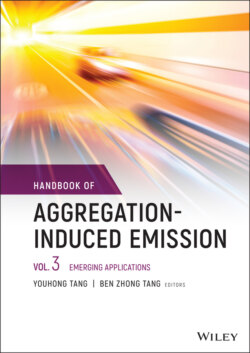Читать книгу Handbook of Aggregation-Induced Emission, Volume 3 - Группа авторов - Страница 42
3.3.2 Thermochromic AIE‐doped Polymer Films
ОглавлениеThermochromic polymer films have been deeply investigated in the recent literature starting from thermoplastic polymer matrices containing small amounts (<5 wt.%) of physically dispersed dyes or fluorophores able to change their optical features after a temperature change above a certain threshold. The working mechanism at the base of such a system mainly consists of aggregation/deaggregation processes among the chromophoric moieties of the dispersed optical probes [13, 52]. As far as the fluorogenic response is concerned, most of the fluorophore selected experienced thermal stress by decreasing or increasing their emission intensity, thus yielding in an ACQ or aggregation‐induced enhanced emission (AIEE) phenomena [66]. Polymer matrices were reported to behave not only as a mere support for the optical probes but their thermal features in terms of melting (or crystallization) temperature and/or glass‐transition temperature can trigger optical changes in the embedded fluorophore. Therefore, thermochromic polymer films were prepared not only to develop optical sensors but also to provide useful information about the structural changes occurring in the supporting polymer matrix by changing the external temperature.
In connection with these findings, AIE‐doped polymer films have been effectively prepared to determine the glass‐transition temperature (Tg) of different polymers and also for possible temperature sensors in correspondence with the viscosity changes occurring near Tg [67]. Below their Tg, thermoplastic polymers become strikingly viscous when their translational and rotational motion are restricted. This phenomenon also causes the sudden arrest of any possible rotation of phenyl rings or analogous moieties in a typical AIEgen physically dispersed or covalently linked to the polymer matrix. Therefore, by lowering the temperature below the Tg, the AIE‐doped polymer film experiences a striking increase of its emission in a typical reversible OFF–ON feature. In a similar manner, Kokado et al. observed the temperature‐dependent fluorescence change in their covalently linked TPE–PDMS polymer, which was mentioned earlier for the mechanochromic behavior [57]. The Tg of the polymer was observed at around −125 °C, and thanks to the presence of the embedded TPE derivative, the fluorescence intensity of the film increased to about eight‐fold at −196 °C. It was worth noticing that the absolute fluorescence quantum yield (ΦF) increased from 7.8 at room temperature to 59%. The ability of the AIEgen fluorophores to detect temperature changes was effectively exploited by Iasilli et al. [56] who incorporated the TPE molecule into different styrene‐based polymers with the aim to determine their Tg via fluorescence, i.e. the PS, the SBS triblock copolymer, and the styrene–butadiene rubber (SBR, a random copolymer) (Figure 3.7). Namely, it is well known that the commercially available amorphous PS shows a Tg of around 90 °C, whereas SBR utilized in their work displayed a Tg at −21 °C. Conversely, SBS (one of the most common thermoplastic elastomers) has two different Tgs, one at 70 °C and the other at −87 °C corresponding to the incompatible but covalently linked blocks of styrene and butadiene, respectively. As a consequence, only PS is totally in a glassy state, whereas SBS only partially (only the PS blocks), and SBR is amorphous but not glassy at room temperature. These features were effectively reflected on the emission properties of the derived films containing the 0.1 wt.% of TPE. Among the above three films, the TPE‐doped PS actually showed the highest ΦF of around 10%, which was lowered to about 2.5% for the doped SBS matrix. In agreement, the SBR films, in which the TPE molecules maintain their phenyl rotations active, are practically nonemissive since the de‐excitation process occurred via nonradiative pathways.
Figure 3.7 Fluorescence ΦF of PS, SBS, and SBR films doped with 0.1 wt.% of TPE. The inset shows the TPE‐doped PS and SBS films under the excitation of a long‐range UV lamp at 366 nm.
The higher emission of the doped PS film with respect to the corresponding SBS matrix can be easily visualized by exposing the materials to the excitation of a long‐range UV lamp at 366 nm (Figure 3.7, inset). Analogously, Tang et al. proposed a similar investigation [68], also taking advantages of more sensitive AIEgens with TICT features [69], and achieved a reliable, simple, and fast method for high‐contrast visualization and differentiation of micrometer‐sized phase separation in polymer structures and blends [70]. This method was based on the RIR and on the TICT of several AIEgens, whose fluorescence features (i.e. emission intensity and wavelength) changed in different polymer phases with different rigidities and polarities. Therefore, each polymer phase can be easily labeled and promptly identified thanks to the different fluorescence intensities and wavelengths with high contrast and low background noise.
Recently, Guo‐Dong Liang et al. took advantages of these findings, labeling PCL macromolecules with the 13 wt.% of TPE via covalent bonding [71]. The polymers showed the typical AIE characteristics in solution and appeared thermally stable above 300 °C. Notably, differential scanning calorimetry (DSC) scans evidenced the presence of a broad endothermic peak from 28 to 54 °C, which is attributed to the presence of a crystalline content of about 56%. The authors reported that TPE molecules included in the PCL polymer matrix (Figure 3.8) above the surface of lamellar crystals have intramolecular motions of the phenyl rings completely arrested, thus providing a bright luminescence at 470 nm.
Figure 3.8 Chemical structure of the TPE‐functionalized PCL polymer and reversible color changes upon heating–cooling solicitations.
This emission was found to progressively decrease upon heating from −10 to 60 °C with a 35‐fold variation of the overall fluorescence intensity. Since at temperature higher than 30 °C PCL‐crystalline phase melts, TPE moieties increase their mobility, thus allowing de‐excitation processes via nonradiative pathways more probable. The reversible thermochromic behavior suggests a new avenue in the development of optical temperature sensors based on AIE‐doped polymer films.
